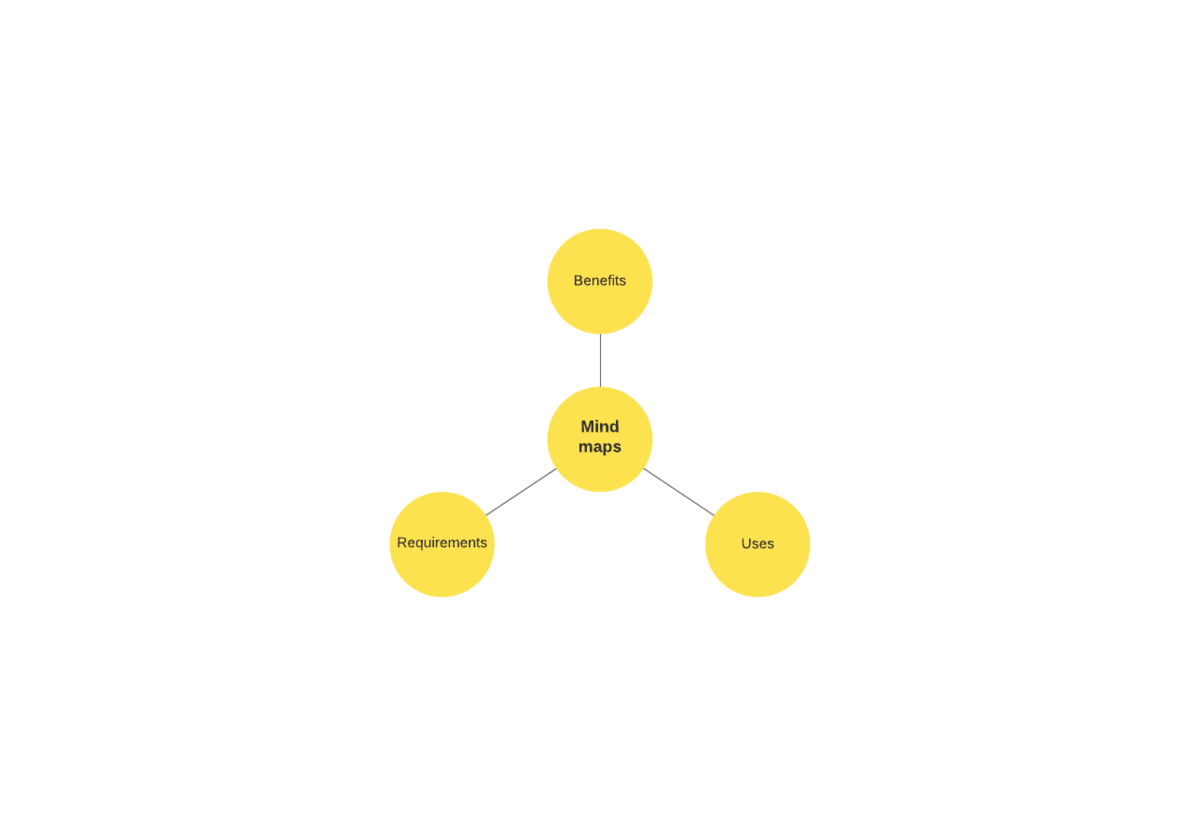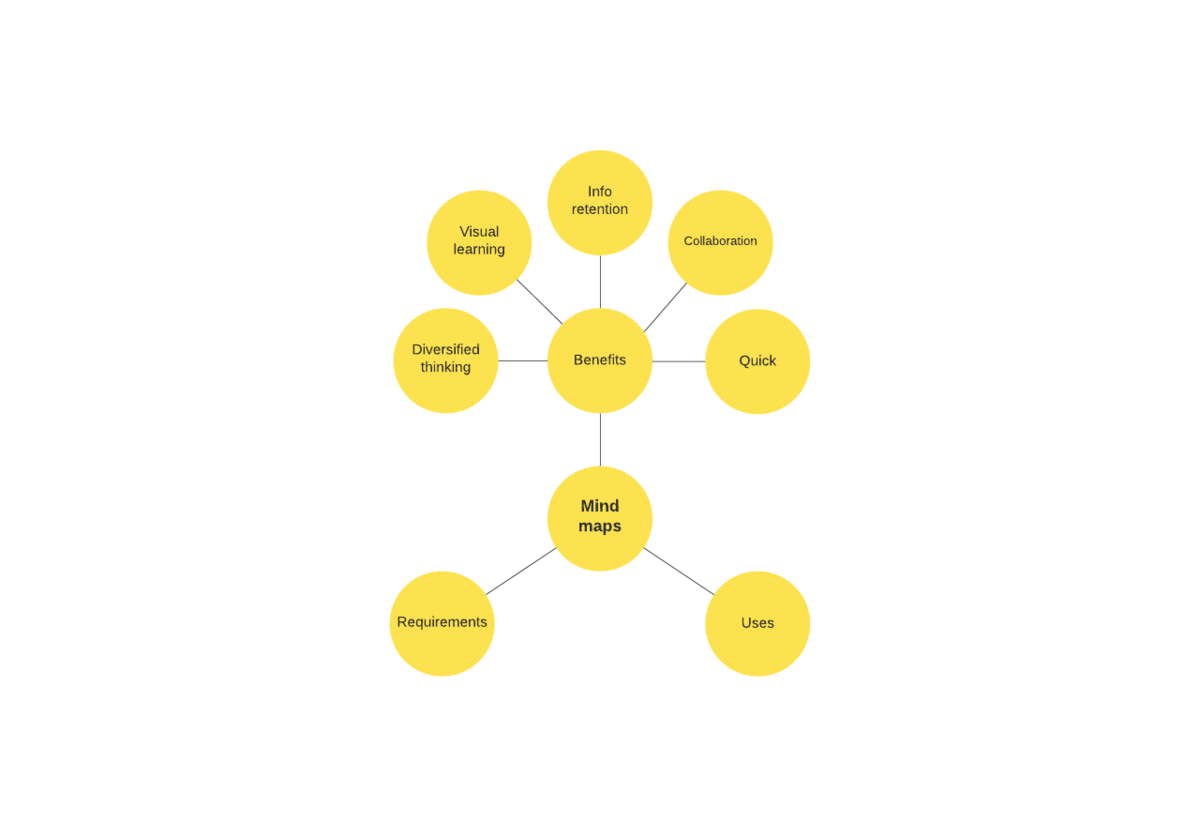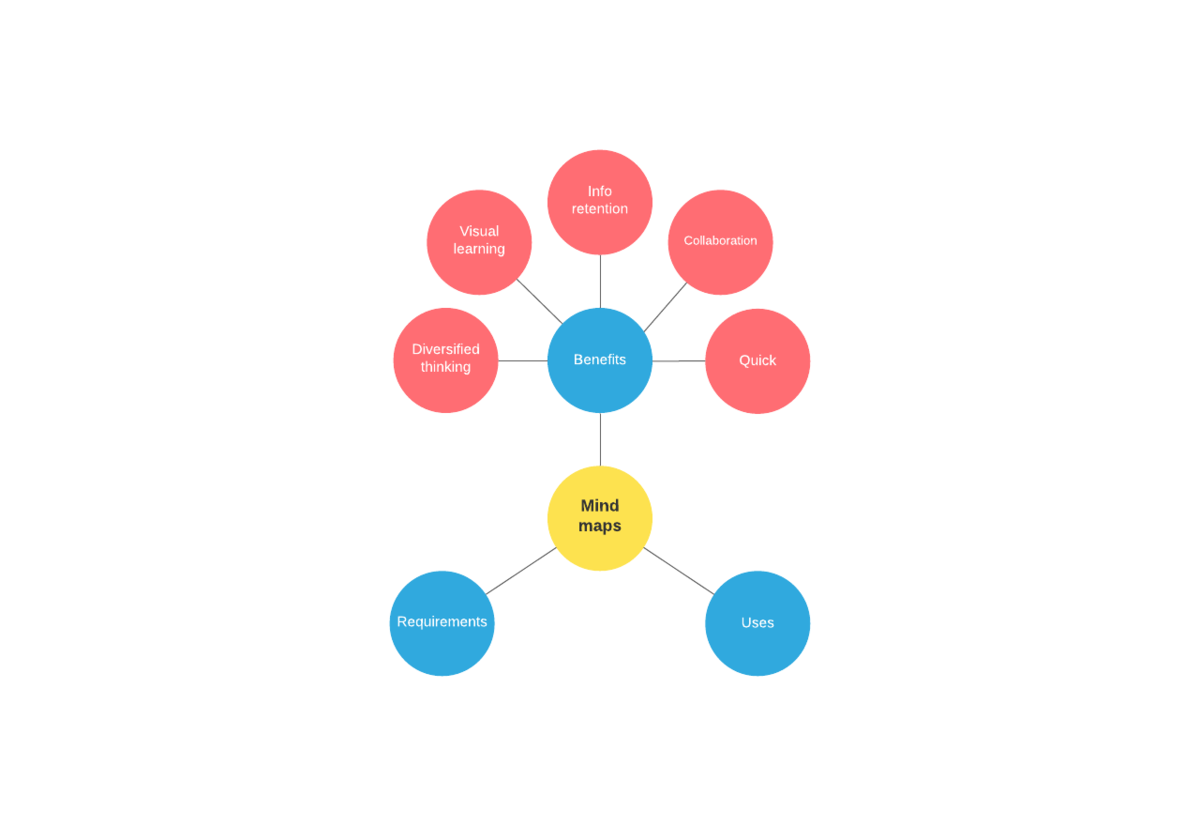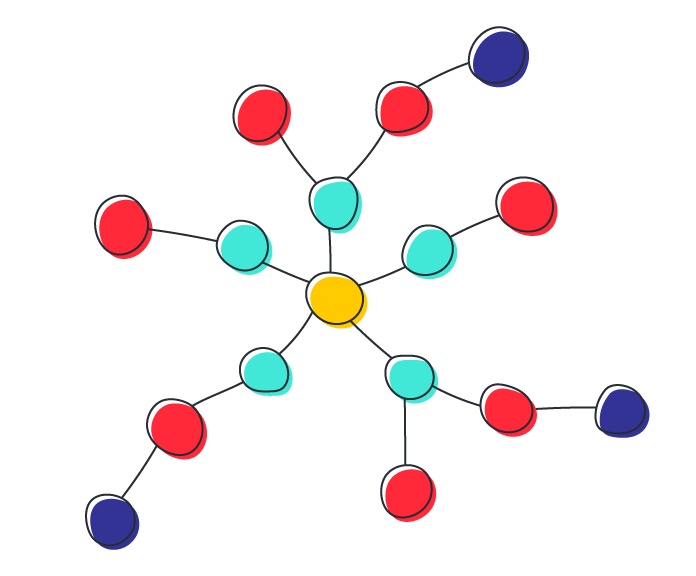A mind map is an easy, organic way to organize ideas, concepts, tasks, and other items without limiting your brainstorming to a linear structure. Usually constructed with a central idea or goal in the middle of the diagram, lines are used as branches to link related themes, then specific items, back to the central concept.
Mind maps are a creative, flexible alternative to other, more structured forms of idea organization. Whether you choose to outline your mind map using pen and paper or an ideation software like Lucidspark, you have free reign to use whatever formatting, colors, or visuals will help you stay organized and retain information.
What is mind mapping?
Mind mapping is a creative process used to get information “in and out” of the mind. Rather than recording information in a monotonous list, however, mind mapping allows you to record your ideas in a less rigid, non-linear format. With a mind mapping software like Lucidspark, you can quickly get all of your ideas out in one document, which you can modify and manage as your ideas evolve.
Benefits of mind mapping
Mind maps offer a number of benefits, both as a visual and as an exercise.
They improve learning and creativity: Even the simple act of jotting down notes on a document can help you learn information. With a mind map, though, simply jotting down notes turns into building connections between different ideas. The process of figuring out how ideas relate to each other can help uncover new connections that you might not have considered previously.
They improve memory retention: Our brains respond much better to visual images than lists of words. An organized mind map can help you better retain information by visually contextualizing and connecting themes and ideas around one central topic. By adding visual queues like colors or shapes, you can increase your chances of remembering key details.
They simplify complex ideas or projects: Mind maps offer the perfect structure for distilling and clarifying large concepts. By visually breaking down your central concept into more digestible ideas, you can create a clear picture of how large ideas or projects break down into smaller items or tasks.
They’re flexible: Mind maps can be made however and whenever necessary, regardless of subject matter or audience. Mind mapping is excellent as a solo activity or in groups when brainstorming or presenting ideas to a team. And because their structure is so intuitive, mind maps can be used by everyone from first graders to executives.
Elements of a mind map
While no two mind maps are the same, generally all mind maps should include the following elements:
A main idea: Every mind map should revolve around a central idea, event, or project. It can be placed in the center of the page, off to one side, or at the top of page, depending on how you’d like to organize your mind map.
Several main themes, or “branches”: From the central concept should come several main themes, which can be linked directly back to the central idea. These themes are usually referred to as first-level associations and provide broad categories into which smaller items can be organized. Fewer is better when thinking of first-level associations—try to limit yours to seven.
Smaller ideas, or “twigs”: Smaller, more specific ideas are referred to as “twigs” or second-, third-, fourth-level associations, etc. Each association should provide more specific information than the twig preceding it.
Keywords: Keywords are used in place of complete sentences to summarize information succinctly. These keywords provide users with more creativity and clarity as they build out their mind map.
Colors or images: While colors and images are not mandatory, experts suggest that the use of images and colors offers additional clarity that can assist in information retention.
Mind mapping techniques
Mind maps are an invaluable tool for those looking to improve big-picture thinking, problem-solving, and planning. They can be implemented in any number of scenarios to promote team collaboration and enhance the brainstorming and learning processes. Here are a few ways mind mapping can be implemented.
Mind mapping in education
Regardless of what subject you’re trying to teach or learn, a visual representation of information can simplify important concepts and foster creative approaches to learning. Mind maps can be used by both educators and students to cultivate valuable learning opportunities and maximize retention.
Mind mapping techniques for educators
Brainstorming sessions: Teachers can use mind maps to expand on new ideas as they’re introduced, teach creative problem solving skills, or assist with overall comprehension. Teachers can create a central mind map for the whole class to see or have students create their own mind maps.
Testing comprehension: Teachers can ask students to create mind maps that test their comprehension of new ideas, assigned readings, and more.
Teaching problem-solving techniques: Using a mind map, teachers can outline hypothetical or real-life problems and have students brainstorm different solutions. Each solution can be divided into individual tasks to help students understand what steps should be taken to reach a solution.
Mind mapping techniques for students
Note-taking: Most students struggle with retaining information that’s been regurgitated onto the page. By organizing information into a visually engaging diagram, students can deepen their understanding of any topic.
Writing outlines: Mind maps are the perfect substitute for linear writing outlines. Not only do they allow students to get their thoughts and ideas on the page quickly, but they also help students decide how best to organize various concepts and ideas.
Mind mapping in business
Organizations thrive when they’re able to foster creative, collaborative environments. Mind maps do just that. Here are a few techniques that can be implemented in any organization to foster productivity and effective teamwork.
Group alignment: Make sure your team is on the same page regarding projects, problems, and more by holding a mind mapping session. Mind mapping as a team will give each team member a chance to contribute ideas to the group while also providing your team with a universal understanding of the idea at hand.
Project planning: Planning a project becomes much easier when overarching goals can be refined and broken down into more manageable tasks. Use mind mapping to help you assign tasks, budget your resources, and estimate project timing.
Decision-making: A simple mind map can help you and your team weigh out the various factors that lead to thoughtful, deliberate decisions. Easily organize pros and cons, generate alternative approaches to problems, and think through potential outcomes all in one diagram.
How to make a mind map
Take the following steps to create an effective, comprehensive mind map.
1. Start with a main idea, task, or concept: Determine the purpose of your mind map, whether it’s planning a project, exploring an idea in depth, or brainstorming solutions to a problem. Place the central topic of your mind map on your document with room to add branches and individual items.
As an example, let’s dissect “mind maps” as a concept.

2. Add branches to your main topic: Break your topic up into basic subtopics, themes, or even tasks. Boil down each branch into a keyword or short phrase to keep things simple.
For example, we can break down “mind maps” into the following three categories.

3. Go in depth with additional branches or twigs: Once your main subtopics have been identified, you can flesh out each topic with specific examples of each. Organize your thoughts by keeping your broader, more important ideas closer to your central topic.
To continue with our example, we’ll break down the subtopic “benefits” into the following key ideas.

4. Add visuals: Part of the reason mind maps are so effective is their ability to communicate and organize information visually. To enhance your mind map’s visual effectiveness, consider adding colors or images to help you further differentiate between various themes or levels of knowledge. Lucidspark also allows for freehand lines and shapes that can highlight various relationships and draw attention to specific details throughout your visual.
To organize our mind map diagram, we can color-code individual sections, add small graphics that help identify specific ideas, and more.

Lucidspark’s infinite canvas is the ideal environment for freeform ideation and brainstorming. With intuitive features such as freehand drawing, sticky notes, and a variety of formatting options, you can quickly and simply make sense of your ideas with customized mind maps.

Want to upgrade your brainstorming or planning sessions?
Try these brainstorming templatesAbout Lucidspark
Lucidspark, a cloud-based virtual whiteboard, is a core component of Lucid Software's Visual Collaboration Suite. This cutting-edge digital canvas brings teams together to brainstorm, collaborate, and consolidate collective thinking into actionable next steps—all in real time. Lucid is proud to serve top businesses around the world, including customers such as Google, GE, and NBC Universal, and 99% of the Fortune 500. Lucid partners with industry leaders, including Google, Atlassian, and Microsoft. Since its founding, Lucid has received numerous awards for its products, business, and workplace culture. For more information, visit lucidspark.com.
Related articles
A guide to utilizing the power of AI for mind mapping
Learn how Lucid's AI tools can supercharge your process of creating mind maps. Includes a free template!

